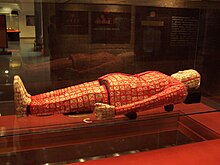Zhao Mo
| Zhao Mo 趙眜 Triệu Mạt | |||||||||
|---|---|---|---|---|---|---|---|---|---|
 Zhao Mo's jade burial suit with red silk, on display in Guangzhou | |||||||||
| King of Nanyue | |||||||||
| Reign | 137–124 BC | ||||||||
| Predecessor | Zhao Tuo | ||||||||
| Successor | Zhao Yingqi | ||||||||
| Born | 175 BC | ||||||||
| Died | 124 BC (aged 51) | ||||||||
| |||||||||
| Dynasty | Nanyue | ||||||||
Zhao Mo (Chinese: 趙眜; Vietnamese: Triệu Mạt) was the grandson and successor of Zhao Tuo and the second ruler of Nanyue, a kingdom encompassing parts of modern-day southern China and northern Vietnam. His rule began in 137 BC and ended with his death in 124 BC.
Name
Records from this period were written in
Zhao's name was recorded as Zhao Hu (Chinese: 赵胡) in the Records of the Grand Historian by Sima Qian. The name of Zhao Mo did not arise until the discovery of two jade seals belonging to the emperor that bore the name of Zhao Mo but not Zhao Hu. "Zhao Hu" may have been an error made by Sima Qian when he was writing his Records. There is also a theory that Zhao Mo and Zhao Hu were two separate rulers and that Zhao Mo's reign was excluded from historical records because of its brief duration.[1][2]
Life

Upon Zhao Mo's accession in 137 BC, the neighboring king of Minyue, Zou Ying sent his army to attack Nanyue. Zhao sent for help from the Han dynasty, his nominal vassal overlord. The Han responded by sending troops against Minyue, but before they could get there, Zou Ying was killed by his brother Zou Yushan, who surrendered to the Han. The Han army was recalled.[3]
Zhao considered visiting the Han court in order to show his gratitude. His high ministers argued against it, reminding him that his father kept his distance from the Han and merely avoided a breach of etiquette to keep the peace. Zhao therefore pleaded illness and never went through with the trip. Zhao did actually fall ill several years later and died in 124 BC. He was succeeded by his son, Zhao Yingqi.[3]
Tomb

The tomb of Wen was discovered in 1983, 20 metres (66 ft) under Elephant Hill in
The tomb also yielded one of the oldest imperial


Alongside Chinese artifacts, pieces from the
The Museum of the Mausoleum of the Nanyue King, located in Jiefang road in Guangzhou, stands on the site of the tomb of Zhao Mo.
Bibliography
- Taylor, Jay (1983), The Birth of the Vietnamese, University of California Press
- Watson, Burton (1993), Records of the Grand Historian by Sima Qian: Han Dynasty II (Revised Edition, Columbia University Press
See also
- Nanyue, Baiyue, and Minyue
- Panyu
- Zhao Tuo and his dynasty
- Museum of the Mausoleum of the Nanyue King
- Zhao Zhongshi
- Đông Sơn culture
References
- ^ Melikian, Souren (8 June 2012). "Exhibition Rewrites the History of Han Civilization in China". New York Times.
- ISBN 978-0-231-08166-5.
- ^ a b Watson 1993, p. 211.


